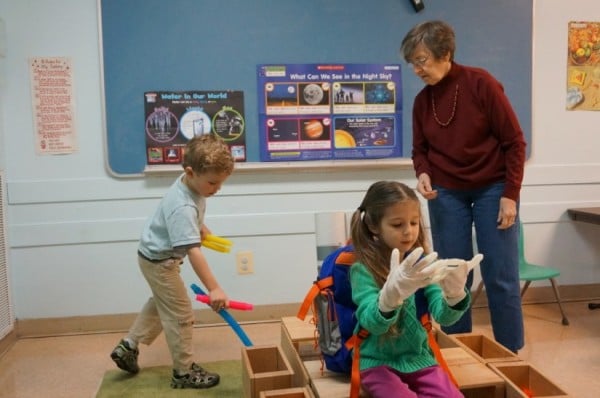
Classic Reston is a biweekly feature sponsored by the Greater Reston Chamber of Commerce that highlights businesses, places and people with deep roots in Reston.
As Fairfax County planners begin to re-evaluate — and possibly re-imagine Reston’s village centers — they may look to what did and did not work with the original plans for the new town.
Reston founder Robert E. Simon envisioned Reston with seven European-style village centers where residents could gather, kids could play and shops could do business. In the mid-1960s, as America’s suburban car culture was building and strip malls and indoor malls were flourishing, Simon’s idea of a central plaza was unique.
And so in the mid-1960s, Lake Anne Village Center was born, followed by Hunters Woods Village Center in 1972. Later village centers in Reston followed a more traditional strip-mall footprint, but they may be rearranged in the future depending on the outcome of this latest comprehensive plan amendment.
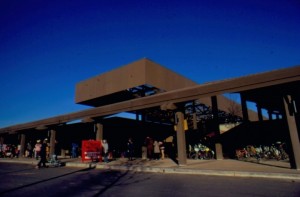 Simon, who at age 100 lives in Heron House overlooking Lake Anne Plaza, still believes that village centers should be the hallmark of Reston. He says that the Reston Master Plan Phase II is a crucial time for Reston’s future and he would like to see
Simon, who at age 100 lives in Heron House overlooking Lake Anne Plaza, still believes that village centers should be the hallmark of Reston. He says that the Reston Master Plan Phase II is a crucial time for Reston’s future and he would like to see
“The village centers are my chief passion, of course,” says Simon. “The reason for the incredible reception (of Reston) when it was built was because of the plazas. I would like to see all the village centers look like Lake Anne, with plazas surrounded by density. Density IS coming to Lake Anne now.”
Simon is referring to Lake Anne Development Partners’ revitalization plan, chosen by the county in 2013, that will bring 60,000 square feet of new retail space, up to 82,500 square feet of office space, and 1,037 residential units near the plaza. The plaza itself will not be altered as it has a historic preservation designation. However, it is expected that the interior of the plaza will see a boost (and some cosmetic work) as more retail and residential is built around it.
The redevelopment is expected to get underway in mid-2015. It will take about 10 years to phase in all developments, Republic officials said.
Republic’s plan was selected by the county after years of studies, discussions and charrettes on ways to revitalize Lake Anne. Lake Anne was once home to a supermarket, a library, a child care center, a coffee house and other retail necessities. But though the lakefront setting was attractive, as the years went on, it proved difficult to get many Restonians out of their cars and running errands by foot.
It was a similar story at Hunters Woods, minus the lake views. The original Hunters Woods Village Center was designed “oriented towards people not automobiles,” according to an early marketing brochure. Some of the more stable tenants over the first 10 years: Drug Fair, Safeway and Baskin-Robbins. Others that came and went: Bangkok West, Big Daddy’s restaurant, La Gazelle, Ryder’s, Pizza Inn, the Seafood Emporium and the Alpenhaus Cafe. Fritzbe’s was a popular restaurant there for 14 years, from 1980 to 1994.
But it did not become the village gathering spot once envisioned. By 1979, Martha Pennino, Reston’s rep on the Fairfax County Board of Supervisors, said the way the center was built was “simply not conducive to good business. People go to the liquor store and the Safeway, and then leave,” the Washington Post reported.
By 1997, the center had been sold several times and a new plan was submitted to the county. The plan called for tearing down the entire 114,000-square-foot center and building a new one in its place.
The “new” Hunters Woods, now 16 years old, now faces the parking lot. Just like Simon was trying to avoid.
Photo of original Hunters Woods Village Center/Credit: Northern Virginia Digital Archives

Classic Reston is a biweekly feature sponsored by the Greater Reston Chamber of Commerce that highlights businesses, places and people with deep roots in Reston.
It’s a big week for Reston with Saturday’s opening of its first Silver Line Metro stop.
Metrorail will connect Reston in a straight shot with Washington, D.C., making the community an attractive option for both residents who work in Arlington or D.C. and workers in Reston who live to the East.
This week’s Classic Reston takes a look at he community’s quirky public transportation link of the 1970s.
When Reston was founded, the “Live, Work and Play,” motto was in place, but in reality, the “work” part was a work in progress. Most Restonians worked in D.C., and it was a long commute with no Dulles Toll Road or Orange Line Metro to Vienna.
But Restonians saw the need for a commuter transit, so — in the true pioneer spirit of the place — they founded a service themselves. In the early 1970s, the Reston Community Association (RCA) and Reston developers Gulf Reston, created the Reston Community Bus Service (RCBS).
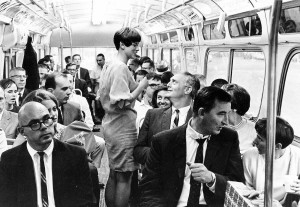 Some in Reston nicknamed the bus “the booze bus,” since there were free-flowing drinks onboard. Well, it was a long commute.
Some in Reston nicknamed the bus “the booze bus,” since there were free-flowing drinks onboard. Well, it was a long commute.
The drinks dried up in 1972 after a commuter threatened to complain to the Virginia Alcoholic Beverage Control Board.
“We will inform our riders they are confined to Coke and potato chips unless we hear otherwise,” Reston Commuter Bus officer Howard Pearlstein told an Associated Press reporter in February of 1972.
The shuttle to D.C. lasted a few years, dying out by the late 1970s. Eventually, Reston minister Embry Rucker helped start the Reston Internal Bus System (RIBS), which took people to various parts of the growing community.
After that, if you wanted to get into D.C., you were on your own — until now.
Reston’s new era begins at noon on Saturday, when the first train pulls out of Wiehle-Reston East heading toward Tysons Corner, Arlington and Washington. Find schedules and fare information on Silverlinemetro.com.
And remember, no eating or drinking on Metro — and certainly no cocktails.
Photo: Riding Reston’s Commuter Bus in the 1970s/Credit: GMU Archives

Classic Reston is a biweekly feature sponsored by the Greater Reston Chamber of Commerce that highlights businesses, places and people with deep roots in Reston.
Every summer weekday morning, when dozens of children are dropped off for Reston Association Day Camp at Brown’s Chapel Park, they play among the mature trees close to the chapel.
The trees are original to the plot of land that is now the park. The chapel, however, is not.
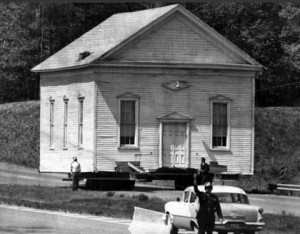 Browns Chapel was originally built in 1879, when Augustus and Sarah Brown deeded a half-acre of land on what is now Leesburg Pike to the “Methodist Episcopal Church.”
Browns Chapel was originally built in 1879, when Augustus and Sarah Brown deeded a half-acre of land on what is now Leesburg Pike to the “Methodist Episcopal Church.”
It remained in use as a chapel until 1967, when the congregation was dissolved. The Northern Virginia Methodist Board of Missions offered the structure to the Fairfax Historical Landmarks Preservation Commission for relocation. That organization in turn contacted Gulf-Reston, Inc., who were by then the developers of Reston.
In May 1968, Gulf-Reston opted to move the 70-ton chapel a few miles down the road to Baron Cameron near Lake Anne. The park, now part of Reston Association, grew around it. Today, it includes baseball fields, a basketball court, picnic facilities, a playground and other recreation amenities. On rainy days at RA Camps, the chapel is a refuge for indoor games.
Meanwhile, a cemetery owned by the church is still located at Baron Cameron and Route 7. More than 200 graves, some of them unmarked, remain. Some of the members were buried there as late as the 1980s — long after the chapel itself was gone.
Photo: Moving Brown’s Chapel in 1968/Credit: Fairfax County

Classic Reston is a biweekly feature sponsored by the Greater Reston Chamber of Commerce that highlights businesses, places and people with deep roots in Reston.
Before there was Reston Now, or Reston Patch, the Reston Connection or the Reston Times (now Fairfax Times), there was the Reston Letter.
In fact, the Reston Letter predates Reston residents.
The Reston Letter was a combination newsletter and marketing material aimed at updating readers about the progress of this “New town” to be built in the cow pasture near the new Dulles International Airport.
See the entire first Reston Letter here.
Volume I, Number I is part of the George Mason University Digital Archives. Let’s take a look at what it was saying about Reston in February of 1963:
Reston is a 10-mile square tract of gently rolling Virginia hill country, 18 miles west of Washington, D.C. and four miles east of the newly opened Dulles International Airport. It is bisected by the airport’s high-speed access highway which takes travelers quickly in and out of the nation’s capital.
Comprising 6,800 acres, Reston could easily have been developed along well trod, conventional lines. Instead, Reston has been planned in a way that suggests a new, creative solution to the twin dangers inherent in America’s enormous population increase and rapidly changing pattern of living — unsightly suburban sprawl and haphazard urban spread.
The letter says Reston hopes to have a population of 75,000 by 1980.
It details the plans for Lake Anne Village Center to resemble a European village where residents can live and shop in the same place. “The first of the seven villages was started in October 1962, when work began on a 500-foot earth dam which will create a crescent-shaped 35-acre lake,” it reads.
The plans for housing units at Lake Anne are detailed, as well as plans for the south end of Reston, where 100 acres would be turned into low density housing surrounding a community horse stable.
“Bridle paths are to be laid out so they lead from the [horse] academy to one of the village centers,” the letter said. “This village will be planned so horse riders will be able to actually ride into town.”
The homes were eventually built (with horse homage street names such as Steeplechase and Paddock). The stables were in action for several years (though hitching the horse at the Hunters Woods Safeway never quite caught on). The barn later burned down, and the site at Steeplechase and Triple Crown is now Pony Barn Pavilion, a Reston Association park.
The early materials encouraged prospective residents that things were about to happen very quickly here.
“By Spring of this year, Reston will be a good place to visit,” the letter says. “By Spring of next year, Reston will be well on its way to becoming one of the best places in the nation in which to live.”
More than 50 years later, has Reston lived up to its marketing? Tell us in the comments.

Classic Reston is a biweekly feature sponsored by the Greater Reston Chamber of Commerce that highlights businesses, places and people with deep roots in Reston.
For Reston’s first 25 years or so, the space now occupied by Reston Town Center was mostly woods and fields.
The location was always planned to be a downtown for Reston, but it took many years to figure out just what exactly that meant.
Reston was originally envisioned by founder Bob Simon as a series of villages with walkable amenities. But after Lake Anne and Hunters Woods were built in the 1960s, the project lost money. It was sold to Gulf Oil and Simon was fired. The vision was then amended, and the remaining “villages” took on a more typical suburban look.
Based on that history, if the planners of Reston Town Center wanted to be different they had better get it right.
By the late 1970s, Mobil Oil Corporation owned the remaining undeveloped land. It formed Reston Land Corporation to continue as the master developer of Reston.
Reston Land Corporation hired Himmel/Miller-Klutznick-Davis-Gray as its development partner for Phase I of Reston Town Center. The two groups then hired RTKL, a Baltimore-based architecture firm, and landscape architects Sasaki in 1984.
The first designs for town center looked more like a typical suburban mall. The mid-1980s, were, after all, still the golden age of malls. Read More

Classic Reston is a biweekly feature sponsored by the Greater Reston Chamber of Commerce that highlights businesses, places and people with deep roots in Reston.
The sounds of construction equipment are as common as the noise of schoolchildren as Reston’s Terraset Elementary School is in the midst of a major renovation and expansion.
When the work is complete, the school will have more than 100,000 square feet of new offices, art and music rooms, classrooms and parking areas. The new Terraset will expand from a capacity of 600 students to around 900.
Going away will be the dual pedestrian bridges over the courtyard that were part of the innovative design of the school when it was constructed in the 1970s. The school itself will remain mostly built into the landscape, something that earned it national attention when it opened in 1977.
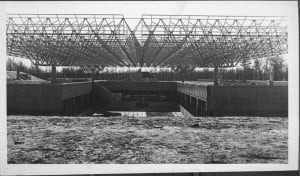 Terraset, translated means “built into the earth,” and coming out of the 1970s energy crisis, the school was touted as the first school on the East Coast to use solar panels as an energy source. In the school’s early years, the solar panels stretched across the entry courtyard.
Terraset, translated means “built into the earth,” and coming out of the 1970s energy crisis, the school was touted as the first school on the East Coast to use solar panels as an energy source. In the school’s early years, the solar panels stretched across the entry courtyard.
The Fairfax County School Board designed Terraset as an experiment in moving away from oil dependency at its schools. FCPS applied for a $625,000 grant from the National Science Foundation to pay for the panels, but it was turned down.
The county then found another money source for the project: Fahd bin Abdul Aziz Al Saud, the former king of Saudi Arabia.
The arrangement earned lots of national attention.
“I remember various times when there would be tour groups walking around the school, peeking into the wall openings,” said Susan Sather, a Reston resident who was a student at Terraset in 1977.
“Usually the groups were reporters, but at least a couple of times it was the Saudis in full length white robes with head coverings [but exposed faces]. I only remember Saudi men. I know the opening was covered by all the DC news channels, and everyone was watching that evening to see ourselves.”
But, alas, the panels were built for Saudi Arabia’s hot climate, not Virginia’s fluctuating temperatures. The energy savings were negated by repair costs and safety issues. Ice that formed on the panels in winter made several fall, and that was a safety hazard for children. The panels were removed in the late 1980s.
However, Terraset’s commitment to the earth remains. While the addition will provide a more traditional classroom structure for the building, the main part will remain underground. Children have always played on the “roof” of the school, which is a grass-covered field. Nearby is the school’s butterfly garden and an outdoor learning area.
Photo: Terraset’s solar panels in the late 1970s/Credit: Reston Historic Trust

Classic Reston is a biweekly feature sponsored by the Greater Reston Chamber of Commerce that highlights businesses, places and people with deep roots in Reston.
Reston was planned in the 1960s, founder Robert E. Simon purposely left one thing out: a cemetery.
Simon says when his family owned New York’s Carnegie Hall, he had dealings with people in the funeral industry. He did not like what he saw, so he was not eager support the business.
But an entire generation has now lived, worked and played in Reston. It is too late to have loved ones buried here — there is no open space for a cemetery now — but a group of Restonians has been working to get a memorial garden in Reston.
“There is no special area here for people to be remembered, where we can go to honor and celebrate Restonians who have passed,” said Joe Ritchey, board chair and president of the Initiative for Public Art Reston (IPAR).
IPAR representatives are working with a Memorial Garden of Reflection committee to identify space and design a place of reflection in Reston. Members of the group spoke at last week’s Baron Cameron Park Master Plan meeting about its hope to be included in the park plans.
The Reston Master Plan changes approved by the county supervisors in February also included the framework for such a place.
“From its beginning in 1964, the planned community of Reston has lacked a special place where one can go to remember and memorialize loved ones. A clear vision for such a facility has emerged through IPAR. It should be a universal and inclusive place where Restonians can remember and reflect upon the passing of loved ones. It should respect and support the many ways in which people choose to acknowledge the passing of life. It’s design should provide a setting for tranquil reflection, contemplation, meditation, inspiration and healing,” the plan states.
The IPAR committee was formed in 2011 after the death of IPAR supporter Ann Rodriguez. It envisions a one-acre site at either Baron Cameron or Lake Fairfax Park. The site should feature natural beauty, wooded elements, as well as walkways and benches, the committee says. Once the project is awarded a site, the next steps will be to raise money to fund the project, as well as hire a landscape designer.
“In the 46 years I have lived in Reston, I have made some very close friends,” said Memorial Garden Committee Chair Sally Brodsky. “Some of them have died. I don’t grieve them in the sense I miss them every day. But I know when I can go to a place where it is quiet, my memories start popping up. In that process, I remember my close friends. I think we all need that. We have every way to be active in Reston, but we need a quiet serene place we —can just be.”
Reston will celebrate its 50th anniversary (and Simon’s 100th birthday) at Founders Day from noon to 3 p.m. Saturday at Lake Anne Plaza. Complete schedule and details.

Classic Reston is a biweekly feature sponsored by the Greater Reston Chamber of Commerce that highlights businesses, places and people with deep roots in Reston.
More than a dozen years ago, the idea was hatched to offer commemorative bricks to Restonians for a permanent place at Lake Anne Plaza.
Since then, nearly 700 bricks have been dedicated at Reston’s original village center, says Lynn Lilienthal, longtime Reston resident and former chair of the Reston Historic Trust.
And with Reston’s 50th anniversary and founder Robert E. Simon’s 100th birthday approaching next month, 2014 will be a big year for commemorative bricks. About 50 bricks will be dedicated at the 2014 Founder’s Day on April 5. That’s about twice as many as in a typical year, says Lilienthal.
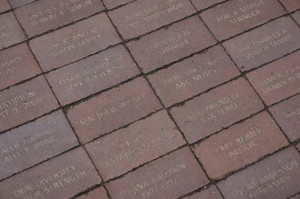 “When we started the project, we thought it would be a good fundraiser,” said Lilienthal.
“When we started the project, we thought it would be a good fundraiser,” said Lilienthal.
While the nonprofit Reston Historic Trust does make some money from the bricks, Lilienthal says she is proud of the way the bricks have turned into a historic timeline of Reston founders, original residents and other people who have had an impact on the community over the years.
Most of the bricks honor people who still live in Reston, but many memorialize those who are no longer with us. The latter is particularly important at the 50-year mark, as many founders have died, Lilienthal says.
Simon purposely designed Reston without a cemetery as he thought the funeral home business was money-hungry. So the bricks serve as kind of memorial, though Lilienthal makes it clear “they are commemorative, not a graveyard.”
Among some of the people memorialized in the bricks are members of Simon’s family: his parents Robert E. Simon Sr. (1877-1935) and Elsa (1885-1964), as well as sisters Helen, Betty and Carol, and his late son, Paul.
Other memorials include former Reston Used Book Shop co-owner Victoria Reid, who died in 2004; arts and civic leader Ann Rodriguez (2009); and Leonard Taylor, Norma Cruz Kahn and Norma Lang Steuerle, who perished on American Airlines Flight 77 on Sept. 11, 2001.
This year, seven bricks have been purchased by “The Kids on The Plaza,” a group of people who grew up in Reston and are now in their 40s and 50s. They raised money to honor 11 among them who died young but will now be memorialized near where they spent so many good times at Lake Anne.
If you are looking for a particular brick, stop by the Reston Historic Trust and Museum at Lake Anne Plaza. The museum has a database of where each brick is located.

Classic Reston is a biweekly feature sponsored by the Greater Reston Chamber of Commerce that highlights businesses, places and people with deep roots in Reston.
Before there was a widespread movement to buy local, reuse and recycle, there was Small Change Consignments.
In 1981, Susann Gerstein was a New York transplant with young children who found herself with time on her hands and an idea. Kids grow out of their toys and clothes so fast — why was there no children’s consignment store in Reston?
Gerstein teamed with two friends, and they opened Small Change at Lake Anne Plaza, unsure of what kind of reception they would find.
“This was before people even recycled newspapers,” she said. “But they knew garage sales. We were the only game in town — there was no eBay, no Reston Town Center, no discount stores.”
 The store was successful from the start, says Gerstein. Thirty-two years later, the two other founding partners have moved on, the store has moved to a bigger spot at Lake Anne Plaza and the second generation of consignment shoppers and sellers are the new store regulars.
The store was successful from the start, says Gerstein. Thirty-two years later, the two other founding partners have moved on, the store has moved to a bigger spot at Lake Anne Plaza and the second generation of consignment shoppers and sellers are the new store regulars.
That includes Gerstein’s own now-grown children, who bring their three children by for some Grandma time among the kids’ stuff.
“It’s paradise when they come here,” she said.
Small Change is stocked — even crammed — with kids items, which are generally half of what you would pay retail. There is everything from everyday play clothes to high-end designer wear from Burberry. In winter, North Face jackets are a top seller, Gerstein says. In summer, shoppers are always looking for Keen sandals. Always in demand are pricey strollers (you can get your name on a waiting list if you are in the market for one).
Consignments (great condition only, please) are by appointment, and you can bring in about 25 items at a time. Consigners get a 50/50 split for items selling under $100; a 60/40 split for items over $100 (60 percent to the consigner). The consignment period is two months — you can shop against your credit balance or take cash at the end.
Small Change also carries new items — mostly toys and handmade goods. The store has a wide selection of Melissa and Doug wooden toys and puzzles, Bruder trucks and Guycraft toys. Local crafters make knitted dolls, baby blankets and other gift items.
Gerstein says she is eager to see what changes come to Lake Anne Plaza in the years ahead. She admits the plaza suffers from a lack of foot traffic, particularly in winter. The historic plaza won’t change much under the proposed revitalization plan, but redevelopment of nearby Crescent Apartments and the periphery of Lake Anne should bring more people to the area to live and to shop, she predicts.
“I am delighted [revitalization] is a go,” she said. “This will be a long process, though. It could take 8 to 10 years. I may still be here, but I can’t promise. But I only see positives with the changes. “
Small Change Consignments is located at 1629 Washington Plaza. The store is open Tuesday through Saturday, 10 a.m. to 5 p.m. To make a consignment appointment, call (703) 437-7730. For more info, visit the store’s website or Facebook page.
This is an installment in an occasional series about longtime Reston businesses.
When the first Reston residents settled into their homes in the mid-to-late 1960s, they found they were without many things in the brand-new community. Among the missing: a good preschool. So in the cooperative spirit of both pioneers and Restonians, Lois Male, then a young mother of three, joined together with several other moms to start Hunters Woods Cooperative Preschool.
That was in 1970. By 1972, Male was a teacher at the preschool. More than two generations of Reston children have gone through HWPS, but Male remains. The school — which meets in a simple room above the Glade Pool entrance — is one of Reston’s oldest businesses, and Male is now in her 42nd year there.
In an era of busy families and high-tech learning opportunities, HWPS has an old-school philosophy: that children learn through play and that preschool is an opportunity to be a good citizen, good friend and good listener.
The cooperative element ensures that parents are part of the program too. Parents (other caregivers and nannies can pitch in as well) help out in the classroom on a regular rotation. That enables HWPS to keep tuition low (it starts at $100 a month for the two-day class) and gets the adults involved in what goes on at school.
“I think for the parents to be involved in early childhood development, that is something that continues through grade school and high school,” says Male.
So what has changed in the decades since she first sat down to read a story to Reston’s 3-year-olds?
“Kids are smarter,” says Male. “They are exposed to more. But they are still just neat little creatures. Parents have changed too. We’ve all gotten very busy.”
So that is why a low-tech preschool — full of wooden puzzles and blocks, sand tables and finger puppets — is a good place to get away from it all.
“It is still fun to kind of hold back on some things,” Male says as an assistant teacher sets up blocks that will be a space ship today and bright paints pots on an easel. “We can take apart an iron. We go outside and look for bugs. When the kids come in, they have choices. Then we have “have-to” time in our meeting on the blue rug. They learn to be attentive in a group, to be a friend and respect each other. This will help them when they get to the ‘big school.’ “
“We get to the ABCs and 123s whenever they are ready,” she adds. “You can’t turn it on if it is not there.”
Hunters Woods Cooperative Preschool has 2-, 3- and 4-day classes for children ages 3 to 5 at the Glade Community Room. There are morning and afternoon classes. The school is holding an open house for prospective parents on Jan. 23 at 7:30 p.m. There will also be a playdate for interested students on Feb. 10 and March 10. Visit the school’s website for more information and to register.
Disclosure: HWPS is a RestonNow.com advertiser.


